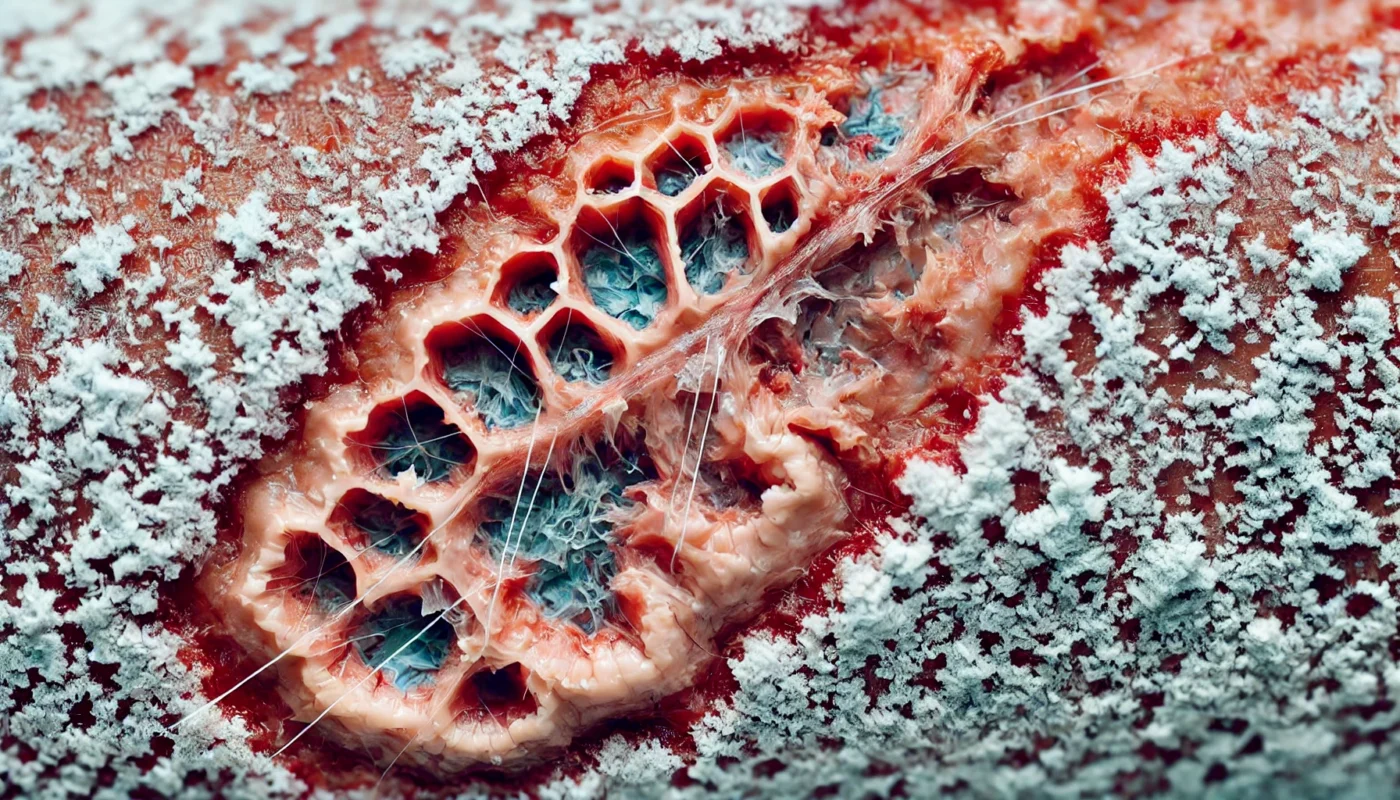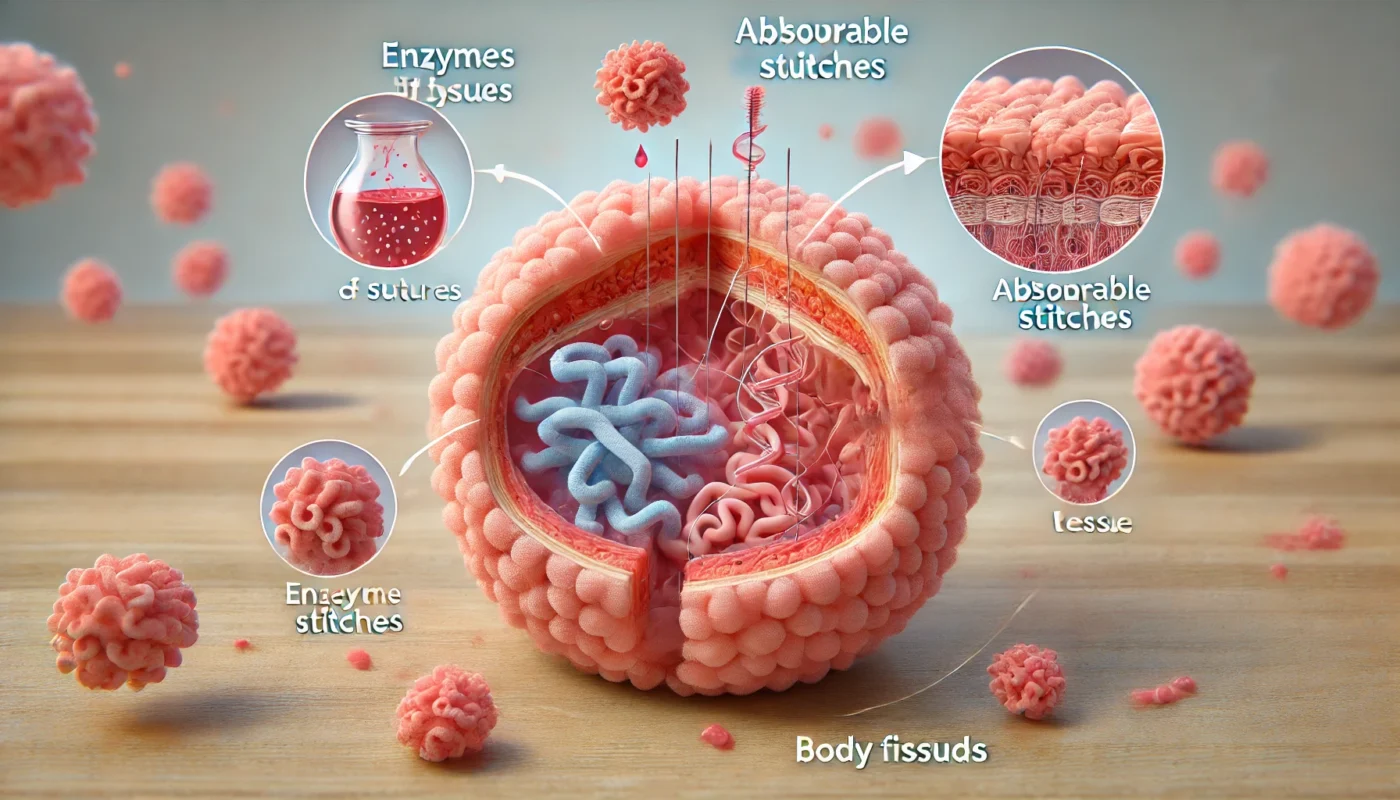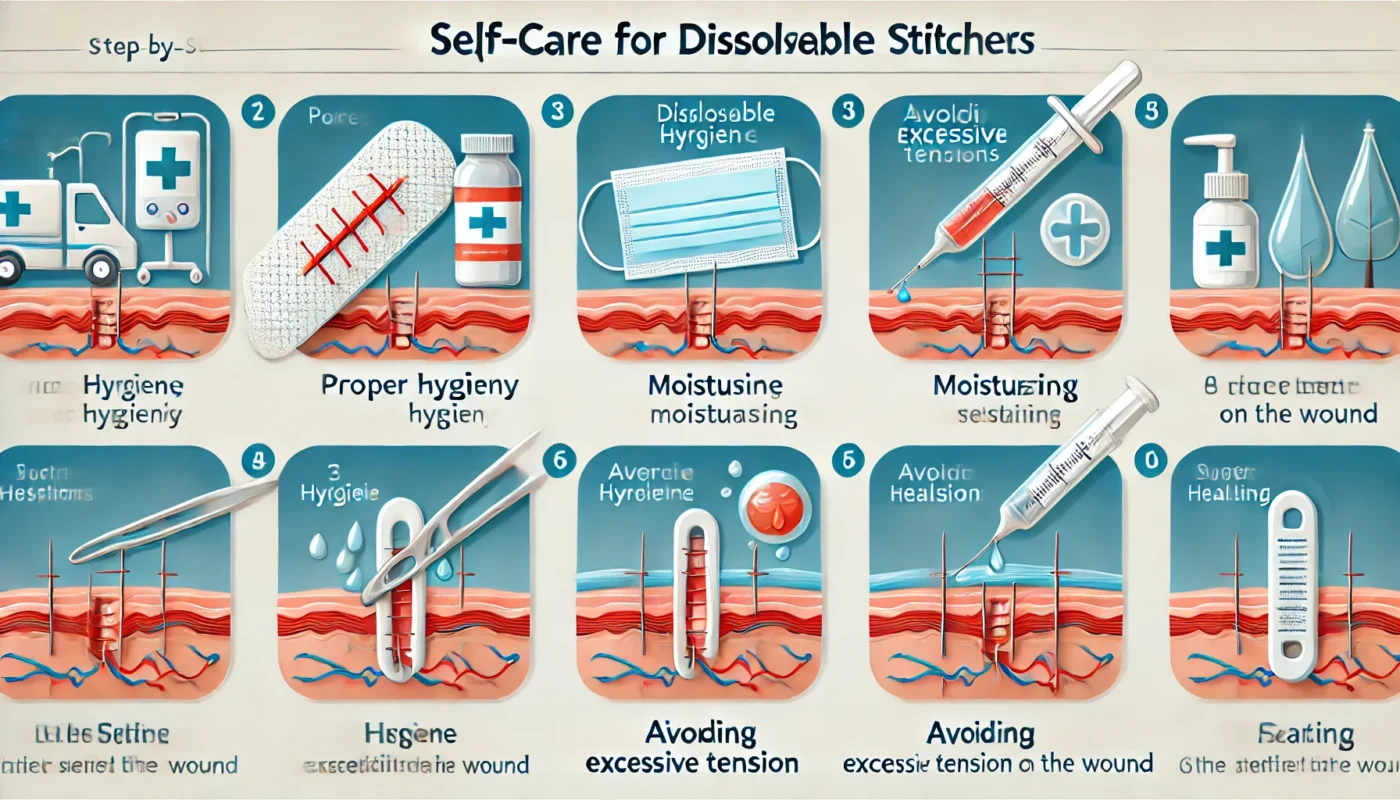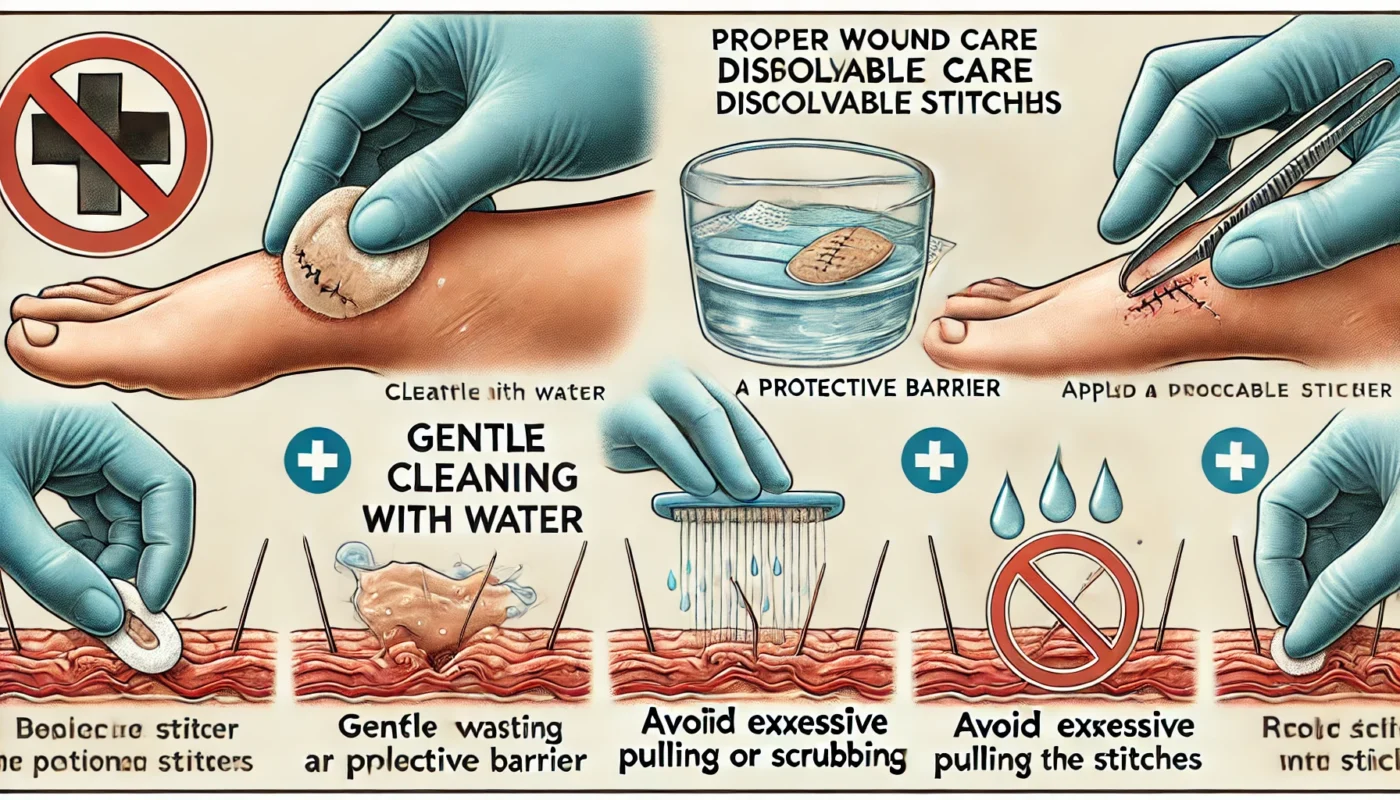Caring for dissolvable stitches, also known as absorbable sutures, is an essential component of post-surgical recovery. Whether you’ve undergone a simple procedure or a complex surgery, understanding how to properly care for these stitches can significantly impact your healing process.
Dissolvable stitches are designed to be absorbed by your body over time, thus eliminating the need for removal. However, this does not mean that they require no care. In this article, we’ll delve into the science behind dissolvable stitches, their healing stages, and how you can optimize your recovery through effective care strategies.
You may also like: Key Factors in Proliferative Wound Healing
Understanding Dissolvable Stitches
Dissolvable stitches are crafted from materials that the body can naturally break down and absorb. These materials can include polyglycolic acid, polylactic acid, or other polymeric compounds. The specific type of suture material used often depends on the nature of the surgery and the expected healing time of the tissue.
Materials Used in Dissolvable Stitches
The materials used for dissolvable stitches are typically biocompatible, meaning they are designed to work harmoniously with the body. Polyglycolic acid and polylactic acid are popular choices because they provide the necessary strength and support while being gradually absorbed. The composition of the stitches is selected based on the tensile strength required to hold tissues together during the initial stages of healing.
Types of Procedures Using Dissolvable Stitches
Dissolvable stitches are commonly used in both internal and external surgical procedures. They are preferred for surgeries where the stitches are not easily accessible for removal, such as internal organ repairs or deep tissue sutures. Additionally, they are often used in pediatric surgeries to avoid the trauma of stitch removal.
Advantages and Limitations
While dissolvable stitches offer the convenience of not requiring removal, they have certain limitations. They may not be suitable for all types of wounds or patients, particularly those with slower healing processes. It’s important to discuss with your surgeon whether dissolvable stitches are the best option for your specific medical condition and surgical procedure.
How Long Before Dissolvable Stitches Dissolve?
One of the most common questions is, “How long before dissolvable stitches dissolve?” The timeframe can vary significantly depending on the type of suture material, the location of the stitches, and individual healing rates. Generally, these stitches can begin to dissolve anywhere from a few days to a few weeks post-surgery. For internal stitches, the process might extend over several months.
The Healing Stages of Dissolvable Stitches
Understanding the healing stages can help you manage your expectations and care more effectively for your stitches.
Initial Healing Phase
In the initial days after surgery, the stitches hold the wound edges together, facilitating tissue regeneration. During this period, it’s crucial to keep the area clean and avoid undue stress on the wound. Proper care during this phase prevents infections and promotes effective healing, setting the stage for subsequent recovery.
Early Signs of Healing
During the initial phase, you may notice some common early signs of healing, such as mild swelling and tenderness. These signs indicate that the body is responding to the injury and beginning the repair process. Maintaining a clean environment and following medical advice is essential to support these natural healing responses.
Importance of Rest
Rest is a critical component during the initial healing phase. Limiting physical activity and allowing the body to focus on repair helps in reducing the risk of complications. Following the surgeon’s advice on rest periods can significantly impact the speed and quality of recovery.
Mid-Healing Phase
As the sutures start to dissolve, you might notice slight redness or a mild itching sensation. This is a normal part of the healing process. However, if you observe significant swelling, pain, or discharge, consult your healthcare provider. Monitoring changes during this phase is crucial to ensure that healing progresses without complications.
Recognizing Normal vs. Abnormal Symptoms
Distinguishing between normal and abnormal symptoms is key during the mid-healing phase. While mild redness and itching are typical, excessive pain or swelling might indicate an issue. Understanding these differences helps in making informed decisions about when to seek medical advice.
Supporting Healing with Nutrition
Nutrition plays a vital role in supporting the body’s natural healing processes. Consuming a diet rich in proteins, vitamins, and minerals can enhance tissue repair and overall recovery. Proper nutrition helps maintain energy levels and supports the body’s ability to regenerate damaged tissues.
Final Healing Phase
By the time the stitches have fully dissolved, the tissue should be well on its way to recovery. At this stage, the focus should be on scar care and ensuring that the healed area maintains its strength and flexibility. Continued care during this phase promotes complete healing and minimizes the risk of complications.
Scar Management Techniques
Effective scar management is crucial during the final healing phase. Techniques such as gentle massage, hydration, and the use of specialized creams can improve the appearance and texture of scars. Addressing scars early on can help in achieving better cosmetic outcomes.
Maintaining Tissue Flexibility
Preserving tissue flexibility is important for functional recovery. Gentle stretching exercises, as recommended by your healthcare provider, can help maintain flexibility without causing stress to the healing tissues. These exercises should be introduced gradually to avoid any setbacks.

Practical Care Tips for Dissolvable Stitches
Keeping the Area Clean
Cleanliness is paramount. Use a gentle soap and water to cleanse the area around your stitches. Avoid scrubbing the wound directly, as this can disrupt the healing process. Pat the area dry with a clean towel.
Choosing the Right Cleaning Products
Selecting appropriate cleaning products is essential for maintaining a sterile environment. Opt for fragrance-free, hypoallergenic soaps to minimize irritation. Ensuring that your cleaning routine supports healing without introducing harmful chemicals is a key component of wound care.
Establishing a Cleaning Routine
Consistency in your cleaning routine can significantly impact the healing process. Establish a regular schedule for cleaning the area to prevent infections and support tissue regeneration. Adhering to a routine ensures that the wound remains free from contaminants throughout the healing journey.
Monitoring for Signs of Infection
Regularly inspect your stitches for signs of infection, such as increased redness, swelling, or warmth. Promptly address any concerns with your healthcare provider to avoid complications. Early detection of infection is critical for timely intervention and effective management.
Understanding Infection Indicators
Recognizing the signs of infection is essential for proactive care. Symptoms like pus, unusual discharge, or a fever could indicate an infection. Being aware of these indicators allows for swift action to prevent further complications.
Communicating with Healthcare Providers
Open communication with healthcare providers is crucial when monitoring for infections. Reporting any unusual symptoms or concerns promptly can lead to quicker diagnosis and treatment. Establishing a clear line of communication ensures you receive the necessary medical support.
Managing Discomfort
Mild discomfort is common as stitches dissolve, but it can usually be managed with over-the-counter pain relief, such as acetaminophen. Avoid non-steroidal anti-inflammatory drugs (NSAIDs) unless advised by your doctor, as they can increase bleeding risk.
Exploring Pain Relief Options
There are various options available for managing pain during the healing process. Besides acetaminophen, certain topical treatments or natural remedies can also provide relief. Understanding the range of pain management strategies can help you find the most suitable option for your needs.
The Role of Rest in Pain Management
Rest is not only important for healing but also in managing discomfort. Allowing the body to rest reduces the strain on healing tissues and minimizes pain. Incorporating adequate rest into your routine can enhance overall comfort during recovery.
Nutrition and Hydration
A balanced diet rich in proteins, vitamins, and minerals can significantly enhance tissue repair. Ensure adequate hydration to support overall health and recovery. Proper nutrition and hydration play a foundational role in the body’s ability to recover from surgery.
Identifying Key Nutrients
Certain nutrients are particularly beneficial for wound healing, such as vitamin C, zinc, and protein. Incorporating these into your diet can accelerate healing and improve outcomes. Understanding the importance of these nutrients allows you to make informed dietary choices.
Creating a Balanced Diet Plan
Developing a balanced diet plan tailored to your recovery needs is essential. Consulting with a nutritionist or healthcare provider can provide personalized guidance on optimizing your diet for healing. A well-structured diet plan supports energy levels and tissue regeneration.
Limiting Physical Activity
Restricting certain movements or activities is often necessary to prevent strain on the healing wound. Follow your doctor’s advice regarding activity limitations and gradually reintroduce regular activities as healing progresses. Appropriate activity management minimizes the risk of disrupting the healing process.
Understanding Activity Restrictions
Understanding the rationale behind activity restrictions helps in adhering to them more effectively. Activities that involve heavy lifting, stretching, or straining the healing area should be avoided. Being aware of these restrictions allows for informed decision-making regarding daily activities.
Gradual Reintroduction of Activities
As healing progresses, gradually reintroducing activities is crucial for regaining normalcy. Starting with low-impact exercises and slowly increasing intensity ensures that the body adapts without causing setbacks. A gradual approach supports recovery while promoting overall well-being.

The Role of Holistic Approaches in Healing
Holistic and alternative approaches can complement traditional medical care by promoting overall well-being and supporting the body’s natural healing processes.
Herbal Supplements
Certain herbal supplements, such as arnica or turmeric, are known for their anti-inflammatory properties and can aid in reducing swelling and promoting healing. However, always consult your healthcare provider before introducing any supplements, as they can interact with medications or affect healing.
Understanding Herbal Benefits
Herbal supplements offer natural alternatives for supporting healing. Understanding the specific benefits and potential interactions of each supplement ensures safe and effective use. Educating yourself about herbal remedies empowers you to make informed decisions.
Consulting Healthcare Professionals
Before incorporating herbal supplements, consultation with healthcare professionals is essential. They can provide insights into the suitability of specific supplements for your condition. Professional guidance ensures that your holistic approaches align with medical treatment plans.
Mind-Body Techniques
Practices like meditation, yoga, and deep-breathing exercises can help manage stress and promote a positive healing environment. Stress reduction is crucial, as stress can impede the body’s ability to repair itself.
Stress Management Strategies
Effective stress management is a cornerstone of holistic healing. Techniques like mindfulness and relaxation exercises can significantly reduce stress levels. Incorporating stress management into your routine supports the body’s natural healing processes.
Integrating Mind-Body Practices
Integrating mind-body practices into your daily routine can enhance overall well-being. Dedicating time to practices like yoga or meditation fosters a healing environment and promotes mental clarity. A balanced mind-body approach complements physical recovery efforts.
Essential Oils
Essential oils, such as lavender or tea tree oil, can be used in aromatherapy or diluted in a carrier oil for topical application (around, but not on, the wound) to support relaxation and antimicrobial benefits.
Selecting Appropriate Oils
Choosing the right essential oils for your needs requires careful consideration. Different oils offer varying benefits, from relaxation to antimicrobial properties. Understanding these differences allows you to select oils that align with your healing goals.
Safe Application Techniques
Ensuring the safe application of essential oils is vital to avoid adverse reactions. Diluting oils properly and using them in appropriate settings enhances their benefits. Following safety guidelines ensures that essential oils contribute positively to your healing process.
When to Seek Medical Advice
While most dissolvable stitches dissolve without issue, it’s important to seek medical advice if you notice any of the following:
- Persistent or worsening pain at the suture site
- Excessive redness, swelling, or warmth
- Pus or unusual discharge
- Stitches that appear to be coming apart prematurely
Recognizing Warning Signs
Being able to recognize warning signs ensures timely intervention. Understanding the symptoms that warrant medical advice helps in preventing complications. Awareness of these signs empowers you to take appropriate action.
Importance of Prompt Action
Prompt action in response to warning signs is crucial for effective management. Delays in seeking medical advice can lead to complications and prolonged recovery times. Acting swiftly ensures that you receive the necessary care and support.
Building a Support System
Having a support system in place can facilitate timely medical intervention. Family and friends can assist in recognizing warning signs and seeking advice. Building a network of support enhances your ability to manage the healing process effectively.

Conclusion
Caring for dissolvable stitches is a multifaceted process that involves both traditional medical care and supportive holistic practices. By understanding the nature of these stitches, their expected healing timeline, and effective care strategies, you can facilitate a smoother recovery.
Remember, each individual’s healing journey is unique, so always consider your personal health needs and consult with healthcare professionals to tailor your care plan accordingly. With the right approach, you’ll be well on your way to a successful recovery and optimal health.
Personalizing Your Recovery Plan
Personalizing your recovery plan ensures that it aligns with your specific needs and circumstances. Consulting healthcare providers and considering holistic approaches can create a comprehensive care strategy. Tailoring your plan maximizes its effectiveness and supports your unique recovery journey.
Emphasizing the Importance of Patience
Patience is a vital aspect of the healing process. Understanding that recovery takes time helps in managing expectations and reducing frustration. Emphasizing patience allows you to approach healing with a positive and resilient mindset.
Celebrating Milestones in Recovery
Celebrating milestones in your recovery journey fosters motivation and encouragement. Recognizing progress, no matter how small, boosts morale and reinforces positive habits. Celebrating achievements contributes to a fulfilling and successful recovery experience.
Further Reading:
How Long Do Stitches Last After Oral Surgery?
How Long Do Dissolvable Stitches Last?
activity restrictions, holistic healing, herbal supplements, stress management, mind-body techniques, essential oils, medical advice, recovery plan, patient care, healing process, wellness, natural remedies, rehabilitation, self-care, mental health
Important Note: The information contained in this article is for general informational purposes only, and should not be construed as health or medical advice, nor is it intended to diagnose, prevent, treat, or cure any disease or health condition. Before embarking on any diet, fitness regimen, or program of nutritional supplementation, it is advisable to consult your healthcare professional in order to determine its safety and probable efficacy in terms of your individual state of health.
Regarding Nutritional Supplements Or Other Non-Prescription Health Products: If any nutritional supplements or other non-prescription health products are mentioned in the foregoing article, any claims or statements made about them have not been evaluated by the U.S. Food and Drug Administration, and such nutritional supplements or other health products are not intended to diagnose, treat, cure, or prevent any disease.

